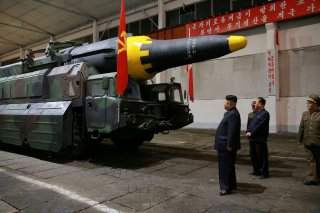Has an Arms Race Begun on the Korean Peninsula?
The ejection test makes South Korea the first country without nuclear weapons to field SLBMs, which are typically designed for compatibility with nuclear warheads.
Both Koreas test-fired ballistic missiles within hours of one another, reigniting long-running military tensions on the peninsula.
The DPRK military fired two ballistic missiles into waters off its Eastern Coast on Wednesday, with South Korean defense officials announcing that the missiles were launched from Central North Korea. The ballistic missile launches follow North Korea’s earlier announcement that the country had tested a new long-range cruise missile. DPRK authorities hinted that their cruise missile can carry a nuclear warhead, though its full capabilities remain unclear.
Seoul responded within several hours with a test of its own, launching a submarine-launched ballistic missile (SLBM) aboard the new Dosan Ahn Changho-class submarine, ROKS Dosan Ahn Changho, in an event attended by President Moon Jae-in. The 3,800-ton Dosan Ahn Changho was commissioned last month and is expected to embark on its first deployment by August 2022.
The ejection test makes South Korea the first country without nuclear weapons to field SLBMs, which are typically designed for compatibility with nuclear warheads. The SLBM, reportedly named Hyunmoo 4-4, appears to be derived from the country’s new Hyunmoo-2B ballistic missile. The Hyunmoo 4-4 reportedly has a range of 500 kilometers, enough to cover all of North Korea.
Although South Korea’s military is already capable of credibly threatening large swathes of DPRK infrastructure and key military assets, the Hyunmoo 4-4 could help Seoul to more effectively target North Korea’s heavily fortified bunkers and underground facilities. “The increase in our missile power can be a sure deterrent against North Korean provocations,” said Moon said in a statement on Wednesday. The new SLBM is part of Seoul’s broader effort to lessen its military dependence on the United States, encompassing a $271 billion, five-year defense procurement plan. The plan likewise envisions a homegrown missile defense network that has been called the “Korean Iron Dome.” The Hyunmoo 4-4 is set to undergo further testing before entering service.
Analysts have remarked on the tests’ unusual timing, as the DPRK’s flurry of missile activity comes amid a bilateral meeting between Chinese foreign minister Wang Yi and Moon. It is arguably uncharacteristic for Pyongyang to stage a provocation of this kind even as its prime benefactor, Beijing, is engaged in high-level diplomatic talks.
Japanese prime minister Yoshihide Suga condemned North Korea’s ballistic missile launches, calling them a “threat to the peace and security” of the region. “It is in violation of UN Security Council resolution, and I strongly protest and condemn this,” Suga said.
The DPRK has lashed out at its southern counterpart, threatening the “complete destruction” of bilateral relations over Seoul’s forceful response to the North’s missile tests. “If the president joins in the slander and detraction (against us), this will be followed by counteractions, and the North-South relations will be pushed toward a complete destruction,” said Kim Yo-jong, sister of North Korean leader Kim Jong-un and influential player in Pyongyang’s internal politics. “We do not want that,” she added.
Mark Episkopos is a national security reporter for the National Interest.
Image: Reuters

